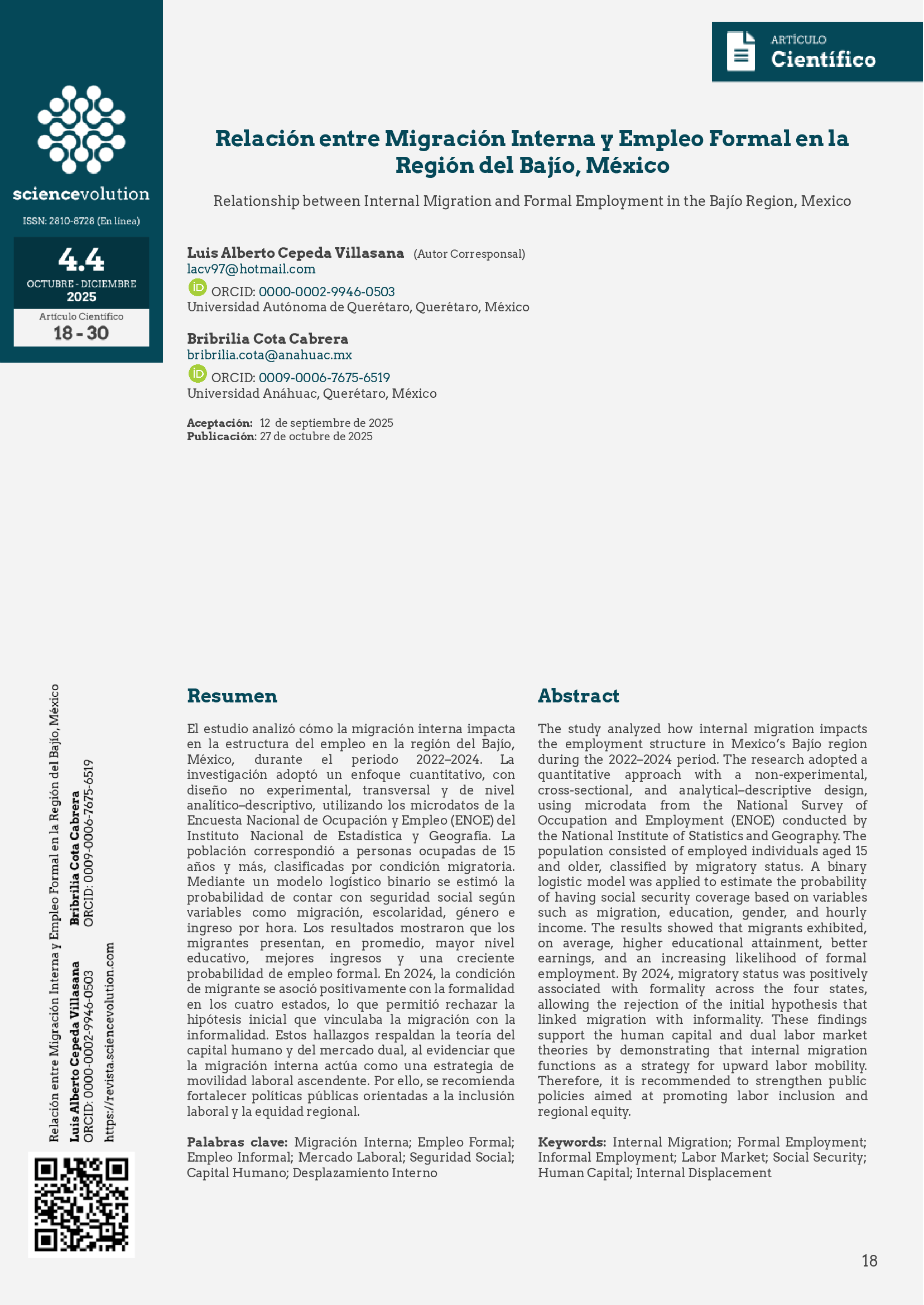Abstract
The study analyzed how internal migration impacts the employment structure in Mexico’s Bajío region during the 2022–2024 period. The research adopted a quantitative approach with a non-experimental, cross-sectional, and analytical–descriptive design, using microdata from the National Survey of Occupation and Employment (ENOE) conducted by the National Institute of Statistics and Geography. The population consisted of employed individuals aged 15 and older, classified by migratory status. A binary logistic model was applied to estimate the probability of having social security coverage based on variables such as migration, education, gender, and hourly income. The results showed that migrants exhibited, on average, higher educational attainment, better earnings, and an increasing likelihood of formal employment. By 2024, migratory status was positively associated with formality across the four states, allowing the rejection of the initial hypothesis that linked migration with informality. These findings support the human capital and dual labor market theories by demonstrating that internal migration functions as a strategy for upward labor mobility. Therefore, it is recommended to strengthen public policies aimed at promoting labor inclusion and regional equity.
References
Basso, M. (2023). Análisis de las migraciones internas en Argentina en el período 2005-2010. Astrolabio, (30), 112-143. https://doi.org/10.55441/1668.7515.n30.35108
Becker, G. S. (1964). Human capital: A theoretical and empirical analysis, with special reference to education. National Bureau of Economic Research; Columbia University Press.
Camargo Bonilla, Y. (2020). La tecnificación exitosa del modelo agrícola empresarial en el Bajío mexicano: maquinaria e infraestructura, 1940-1975. Historia Agraria de América Latina (HAAL), 1(2), 74–99. https://doi.org/10.53077/haal.v1i02.73
Camargo Bonilla, Y. (2022). La adopción del modelo de Revolución Verde en el Bajío mexicano: fitomejoramiento y tecnificación 1940-1970. Mundo Agrario, 23(54), e196. https://doi.org/10.24215/15155994e196
Castillo Robayo, C. D., Prieto, W., & Campo Robledo, J. A. (2024). Impacto de la migración sobre el empleo y la distribución salarial en Colombia. Estudios Fronterizos, 25, 1–13. https://doi.org/10.21670/ref.2412148
Comisión Económica para América Latina y el Caribe. (s.f.). Acerca de migración interna. Naciones Unidas. Recuperado el 1 de septiembre de 2025, de https://www.cepal.org/es/temas/migracion/acerca-migracion-interna
Guevara-Rosero, G. C., Sandoval, D., & Del Pozo, D. (2025). Amenidades y migración interna: Caso ecuatoriano. Instituto Nacional de Estadística y Censos (INEC), (20). https://www.ecuadorencifras.gob.ec/documentos/web-inec/Bibliotecas/Libros/cuadernos_trabajo/Amenidades_migracion_interna.pdf
Guzmán Segura, J. G., & Quezada Garza, P. F. (2025). Determinantes de la informalidad laboral en las zonas metropolitanas mexicanas. Estudios Demográficos y Urbanos, 40, 1-26. https://doi.org/10.24201/edu.v40.e2210
Inquilla-Mamani, J., Salas-Avila, D., Velazco Reyes, B., & Inquilla-Arcata, F. (2023). Migraciones internas como factor del crecimiento de la economía informal en el altiplano peruano. Revista de Ciencias Sociales, 29(4). https://doi.org/10.31876/rcs.v29i4.41274
Instituto Nacional de Estadística y Geografía. (2025a). Encuesta Nacional de Ocupación y Empleo (ENOE), 1-16. https://www.inegi.org.mx/contenidos/saladeprensa/boletines/2025/enoe/enoe2025_08.pdf
Instituto Nacional de Estadística y Geografía. (2025b). Encuesta Nacional de Ocupación y Empleo (ENOE),1-24. https://www.inegi.org.mx/contenidos/saladeprensa/boletines/2024/ENOE/ENOE2024_12.pdf
Johnston, J., & DiNardo, J. E. (2001). Métodos de econometría. Vicens-Vives Editorial, S.A.
Juárez Díaz, D., & García Amador, C. (2025). Evolución y causas de la migración interna en México: un análisis de los periodos 1995-2000 y 2015-2020. Revista Pueblos y Fronteras Digital, 20, 117–140. https://www.scielo.org.mx/scielo.php?script=sci_arttext&pid=S1870-41152025000100117
Lenko, M., Refle, J.-E., Burton-Jeangros, C., Fakhoury, J., Consoli, L., & Jackson, Y. (2024). Migrant work conditions and health status—A longitudinal study on “dirty work” among undocumented and newly regularized workers. Journal of International Migration and Integration, 26, 213–233. https://doi.org/10.1007/s12134-024-01182-5
McAuliffe, M. y L.A. Oucho. (2024). Informe sobre las Migraciones en el Mundo 2024. Organización Internacional para las Migraciones (OIM), Ginebra. https://publications.iom.int/books/informe-sobre-las-migraciones-en-el-mundo-2024
Naciones Unidas & CEPAL. (2023). Métodos para la medición de la migración interna y sus efectos sociodemográficos, con especial atención al uso de los censos y las matrices de migración. https://hdl.handle.net/11362/48923
Osorio-Caballero, M. I., & López Hernández, D. (2022). Informalidad laboral, un análisis regional para México. Panorama Económico, 18(37), 33-56. https://doi.org/10.29201/peipn.v18i37.129
Piore, M. J. (1979). Birds of passage: Migrant labor and industrial societies. Cambridge University Press.
Rodríguez, O. (2022). ¿De dónde salieron y a dónde se fueron? Migración interna de regiones de alta violencia en México en las últimas dos décadas. Revista EURE - Revista De Estudios Urbano Regionales, 48(144), 1–23. https://doi.org/10.7764/EURE.48.144.12
Santamarina + Steta. (2023). Visión 2025: Una mirada al crecimiento del Bajío mexicano. https://santamarinasteta.mx/wp-content/uploads/2023/07/Insight_Vision-2025-Crecimiento-del-Bajio_v2.pdf
Unión Europea & Naciones Unidas. (2023). Recomendaciones internacionales sobre estadísticas de las personas desplazadas internamente (IRIS) [PDF]. https://egrisstats.org/wp-content/uploads/IRIS_SPANISH-VERSION.pdf

This work is licensed under a Creative Commons Attribution-NonCommercial-NoDerivatives 4.0 International License.

